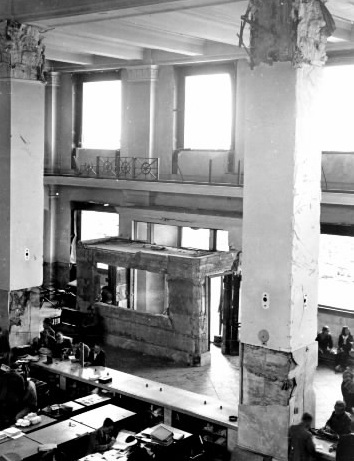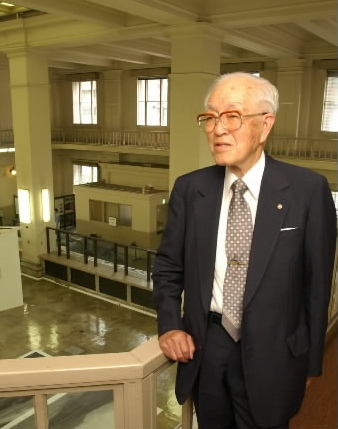Images of the Atomic Bombing, 1945~2003, Part 5
Jun. 26, 2010
Handing down the history of the atomic bombing
by Masami Nishimoto, Senior Staff Writer
In the summer of 2003, the Hiroshima Peace and Culture Foundation obtained 226 photographs from the U.S. National Archives which show the devastation caused by the atomic bombing. The photos the American forces took in their investigation of the effects of the bombing are witnesses that convey the tragedy of that time. This series [originally published in July and August 2003] traces the reality of the atomic bombing through some of these images.
Bank played pivotal role in the city's reconstruction
The Hiroshima branch of the former Bank of Japan is a ferro-concrete building with three floors above ground and a basement. It was completed in 1936 in downtown Hiroshima.
Located 380 meters from the hypocenter, the interior of the third floor was gutted by fire, but the first and second floors and the vault in the basement escaped heavy damage. The fierce force of the blast shook the decorative pillars that stand inside, but transactions resumed as early as two days after the bombing. Accompanied by a former employee who was assigned to work at the branch soon after returning home from war, we visited the only A-bombed building still standing on Rijo-dori Street, which links Hiroshima Castle with City Hall.
"When I got off the train at Hiroshima Station, there was nothing left of the city. I began working at the bank that same day and stayed there from that night."
Kojiro Shinohara, 85, a Hiroshima resident, assumed his post at the Hiroshima branch of the former Bank of Japan in October 1945. When he returned home to the city of Fukuoka from the front, he was assigned to work in Hiroshima. With rumors swirling that "no plants will grow in Hiroshima for 75 years," further fueling the fear of A-bomb-related illness, no one would volunteer to work here.
A total of 37 employees of the branch, including those who had just finished the night shift and those on their way to work, were killed in the blast. In addition, five other employees who had been mobilized for military service, also died. Meanwhile, 12 staff members of the Hiroshima Regional Finance Bureau (now, the Chugoku Regional Finance Bureau), which had been moved onto the third floor of the bank building to avoid possible air raids, perished, too.
Katsuo Aihara, then 46, was head of the Wartime Facilities Section of the Hiroshima Regional Finance Bureau. He detailed conditions at the bank in his account of the bombing, which he contributed to a collection of A-bomb experiences. An excerpt from his account is cited with the consent of surviving family members:
"The south exit to the building was so jammed with people--wounded bank workers; a female streetcar conductor suffering from severe burns to her body; a pitiful young mother holding her infant; and many others--that there was no room to step past. The cries of the dying, voices calling for water, unspeakably gruesome scenes--this was all unfolding."
A report from the branch, dated August 11 and addressed to its head office, testifies to the condition of the city's financial institutions: "Only our bank and the Godo Chochiku Bank have survived." On August 8, amid the aftermath of the bombing, the bank managed to resume business with help from another branch in the city of Okayama. The floor space was temporarily divided and space was allocated to 12 institutions, enabling them to handle transactions with survivors.
"This was the only place where people could withdraw their savings," noted Mr. Shinohara. The confusion continued even after Mr. Shinohara arrived. His responsibilities involved negotiations with the GHQ in Kure, the collection of military scrip, and other matters. To provide detailed reports, he was forced to visit the city of Osaka in person because telephone service had not yet been restored.
In the bank building, with windows boarded by debris but still bringing in the snow, Mr. Shinohara helped with the conversion to the new yen system that was launched in February 1946 to counter the postwar hyperinflation. On his way home at night to the farmhouse he was renting at the time, he was guided by a solitary light glimmering in the dark at Yokogawa Station in Nishi Ward.
"Since I wasn't from Hiroshima, and only knew it as a burnt wasteland, I was amazed at the city's recovery," he said. He recalled feeling awed by the changes that had taken place in the city when he eventually returned to Hiroshima after a 20-year absence to become the branch's manager. Three years later, he was invited to take up a post at Hiroshima Sogo Bank, and he engaged in its business operations as Hiroshima continued to rise from the devastation of the atomic bombing.
The former Bank of Japan maintained the Hiroshima branch until 1992. In 2000, it was loaned out to the city, free of charge, based on the Hiroshima Peace Memorial City Construction Law. The city makes the building available to the public for various events, and is contemplating using it for a venue for art and cultural activities.
Mr. Shinohara led us upstairs in the old bank building and said, "Here are the scars of the bombing." He pointed out deep gouges visible in the marble mantelpiece and wooden walls on the second floor.
"I think there should be some explanation about the history of the branch, in enduring the atomic bombing and playing a key role in the city's reconstruction," he remarked. The building's architectural style is noted inside, but lacking is the viewpoint of passing on the story of the disaster that occurred on that day, and of the journey of the city and her citizens since that time.
Emerging from such images of the atomic bombing is not only a window into tragedy, but a call for human beings today to hand down history.
(Originally published on August 3, 2003)









